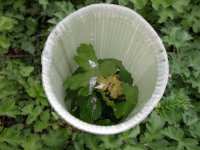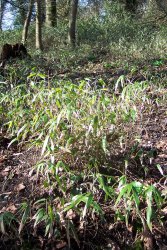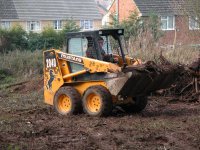|
Species
Conservation
Quizzes:
- Birds
- Butterflies
- Flowers
- Fungi
Picture Gallery
|
|
 |
| |
ConservationIt is important to keep Ridge Wood as a special place and work to increase its beauty and usefulness for all the human and non-human life that encounters it. To do this, it is necessary for humans to intervene in a positive way, a way that is planned.
The native woodland trees need to be encouraged and protected. This is achieved by:
Coppicing
 For centuries, people have coppiced (or stooled) trees in order to use the wood for their own needs. Coppicing allows sunlight to penetrate the wood, encouraging wildflowers and the growth of new saplings. A wood is not coppiced all at one time, but in rotation so that a range of different-age trees are provided which offers a variety of habitats for different creatures. And coppicing is said to lengthen the life of trees, encouraging it to regenerate itself. For centuries, people have coppiced (or stooled) trees in order to use the wood for their own needs. Coppicing allows sunlight to penetrate the wood, encouraging wildflowers and the growth of new saplings. A wood is not coppiced all at one time, but in rotation so that a range of different-age trees are provided which offers a variety of habitats for different creatures. And coppicing is said to lengthen the life of trees, encouraging it to regenerate itself.
(photo: felled Robinia sections)
Pollarding
 This is the process by which a tree is lopped at a certain height. The trunk becomes broad and fissured, providing hidey holes for birds, minibeasts, ferns and lichens. The upper growth is regularly cut back to maintain vigorous, appropriately-sized growth. Again, this method probably prolongs the life of trees. It was a method traditionally used to mark boundaries of parishes, woods etc. This is the process by which a tree is lopped at a certain height. The trunk becomes broad and fissured, providing hidey holes for birds, minibeasts, ferns and lichens. The upper growth is regularly cut back to maintain vigorous, appropriately-sized growth. Again, this method probably prolongs the life of trees. It was a method traditionally used to mark boundaries of parishes, woods etc.
Planting
 Provided there are sunny clearings, woodlands are able to regenerate themselves. But sometimes, they need a little help - then, the planting of carefully-chosen species can add to the wildlife value and structure of the wood. Some of the planting can be in the form of hedges at the wood’s boundaries to provide a protective screen as well as a wildlife habitat in its own right. Provided there are sunny clearings, woodlands are able to regenerate themselves. But sometimes, they need a little help - then, the planting of carefully-chosen species can add to the wildlife value and structure of the wood. Some of the planting can be in the form of hedges at the wood’s boundaries to provide a protective screen as well as a wildlife habitat in its own right.
(photo: felled timber and replanting)
 The native wildflowers - the bluebells and other spring blooms, and the flowers in the small patches of open grassland - also benefit from coppicing and pollarding because of the increased access of sunlight to the ground. It is important that the grassland flowers are not shaded out by taller plants, so this area will be carefully managed to prevent the latter becoming dominant. The native wildflowers - the bluebells and other spring blooms, and the flowers in the small patches of open grassland - also benefit from coppicing and pollarding because of the increased access of sunlight to the ground. It is important that the grassland flowers are not shaded out by taller plants, so this area will be carefully managed to prevent the latter becoming dominant.
(photo: planting a new hedge around the timber stacking area, Feb. 2004)
 The non-native parkland trees make this wood very special and provide special habitats for birds such as goldcrests and tree creepers as well as birds of prey. These trees will be cared for and replaced, if necessary, so that the unique atmosphere of this wood is retained for the future. The non-native parkland trees make this wood very special and provide special habitats for birds such as goldcrests and tree creepers as well as birds of prey. These trees will be cared for and replaced, if necessary, so that the unique atmosphere of this wood is retained for the future.
(photo: young oak tree in planting shelter)
However, sycamore is a parkland tree that seeds prolifically and quickly dominates woodland. This reduces the diversity, interest and wildlife value of the wood. It is important to control sycamore by not allowing the seedlings to establish and even felling some of the older trees.
 Dwarf bamboo Dwarf bamboo
Originally planted as an attractive ornamental, this is also a dominant plant. It is capable of covering the woodland floor quite quickly, at the expense of more delicate flowers. Therefore, it needs to be kept under control.
Birds and bats
These creatures benefit from old trees with lots of nooks and crannies in them so that they can find places to roost and rear their young. However, there are few such venerable trees in Ridge Wood. Therefore, bird and bat boxes will be installed to provide this much-needed habitat.
Paths, glades and rides will be created to allow more sunlight to penetrate the wood and also to enable human visitors to enjoy their visit. The paths will be very ‘natural’ in appearance.
The wider countryside
Little woods in isolation do not thrive for wildlife cannot easily travel from one habitat to another. It is important to care for the wooded corridor to the north of Ridge Wood and encourage other links into the surrounding landscape so that species can continue to move around, colonising and replenishing the countryside.
A place for everyone
 It is hoped that Ridge Wood will be a haven where people can enjoy themselves, learn about their landscape and hopefully, get involved with looking after this special place. This could be doing something very simple - such as taking your litter home - or enjoying the satisfaction of taking part in special conservation workdays. It is hoped that Ridge Wood will be a haven where people can enjoy themselves, learn about their landscape and hopefully, get involved with looking after this special place. This could be doing something very simple - such as taking your litter home - or enjoying the satisfaction of taking part in special conservation workdays.
(photo: clearing tipped rubbish from timber stacking area, Feb 2004)
Ridge Wood has always been a place where people and nature have met and mingled. This process continues into the future - why not become a part of it?
See Management Plan for more details
Some useful wildlife links
Wildlife Watch (Junior branch of Wildlife Trusts)
http://www.wildlifewatch.org.uk/
From Watch - a wildlife diary to print out and fill in:
http://www.wildlifewatch.org.uk/wildlifediary/
RSPB
http://www.rspb.org.uk/
RSPB's comprehensive A-Z of UK birds:
http://www.rspb.org.uk/birds/guide/
RSPB's - how to study owl pellets:
http://www.rspb.org.uk/youth/makeanddo/do/pellet/index.asp
Return to top of page
|
|
| |
|

